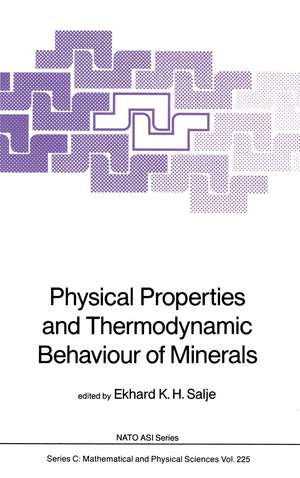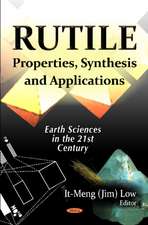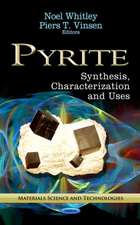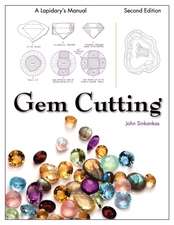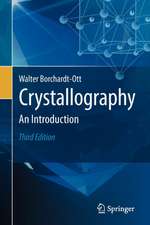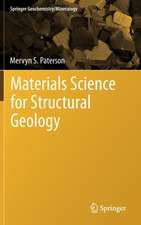Physical Properties and Thermodynamic Behaviour of Minerals: Nato Science Series C:, cartea 225
Editat de Ekhard K.H. Saljeen Limba Engleză Hardback – 31 ian 1988
| Toate formatele și edițiile | Preț | Express |
|---|---|---|
| Paperback (1) | 1836.49 lei 6-8 săpt. | |
| SPRINGER NETHERLANDS – 10 noi 2011 | 1836.49 lei 6-8 săpt. | |
| Hardback (1) | 1844.05 lei 6-8 săpt. | |
| SPRINGER NETHERLANDS – 31 ian 1988 | 1844.05 lei 6-8 săpt. |
Din seria Nato Science Series C:
- 24%
 Preț: 797.66 lei
Preț: 797.66 lei - 18%
 Preț: 957.62 lei
Preț: 957.62 lei - 18%
 Preț: 957.13 lei
Preț: 957.13 lei - 18%
 Preț: 1227.52 lei
Preț: 1227.52 lei -
 Preț: 396.40 lei
Preț: 396.40 lei -
 Preț: 403.75 lei
Preț: 403.75 lei - 18%
 Preț: 1239.37 lei
Preț: 1239.37 lei - 18%
 Preț: 1236.51 lei
Preț: 1236.51 lei - 18%
 Preț: 1231.78 lei
Preț: 1231.78 lei - 18%
 Preț: 1229.10 lei
Preț: 1229.10 lei - 18%
 Preț: 1835.21 lei
Preț: 1835.21 lei - 24%
 Preț: 1076.36 lei
Preț: 1076.36 lei -
 Preț: 390.46 lei
Preț: 390.46 lei -
 Preț: 369.63 lei
Preț: 369.63 lei - 18%
 Preț: 1232.41 lei
Preț: 1232.41 lei -
 Preț: 394.51 lei
Preț: 394.51 lei - 18%
 Preț: 1226.24 lei
Preț: 1226.24 lei - 18%
 Preț: 1845.80 lei
Preț: 1845.80 lei -
 Preț: 399.88 lei
Preț: 399.88 lei -
 Preț: 384.28 lei
Preț: 384.28 lei -
 Preț: 390.88 lei
Preț: 390.88 lei -
 Preț: 381.19 lei
Preț: 381.19 lei - 18%
 Preț: 1848.64 lei
Preț: 1848.64 lei - 18%
 Preț: 951.14 lei
Preț: 951.14 lei - 18%
 Preț: 1230.35 lei
Preț: 1230.35 lei - 18%
 Preț: 1236.51 lei
Preț: 1236.51 lei -
 Preț: 401.03 lei
Preț: 401.03 lei -
 Preț: 406.25 lei
Preț: 406.25 lei - 18%
 Preț: 1230.84 lei
Preț: 1230.84 lei -
 Preț: 418.34 lei
Preț: 418.34 lei - 18%
 Preț: 1223.74 lei
Preț: 1223.74 lei
Preț: 1844.05 lei
Preț vechi: 2248.84 lei
-18% Nou
Puncte Express: 2766
Preț estimativ în valută:
352.85€ • 368.41$ • 292.03£
352.85€ • 368.41$ • 292.03£
Carte tipărită la comandă
Livrare economică 05-19 aprilie
Preluare comenzi: 021 569.72.76
Specificații
ISBN-13: 9789027726568
ISBN-10: 9027726566
Pagini: 736
Ilustrații: XXIV, 707 p.
Dimensiuni: 155 x 235 x 45 mm
Greutate: 1.23 kg
Ediția:1988
Editura: SPRINGER NETHERLANDS
Colecția Springer
Seria Nato Science Series C:
Locul publicării:Dordrecht, Netherlands
ISBN-10: 9027726566
Pagini: 736
Ilustrații: XXIV, 707 p.
Dimensiuni: 155 x 235 x 45 mm
Greutate: 1.23 kg
Ediția:1988
Editura: SPRINGER NETHERLANDS
Colecția Springer
Seria Nato Science Series C:
Locul publicării:Dordrecht, Netherlands
Public țintă
ResearchCuprins
1. The Microscopic Mechanisms of Complex Structural Phase Transitions.- 1. Introductory remarks.- 2. Microscopic mechanisms.- 3. Computer modelling.- 4. The Landau free energy function.- 5. Critical fluctuations.- References.- 2. The Thermodynamics of Short Range Order.- 1. Introduction.- 2. Symmetry Principles for interactions in modulated structures.- 2.1 Symmetry groups and their irreducible representations.- 2.2 The origin of selection rules for interactions.- 2.3 The nature of irreducible representations of the space group.- 2.4 Symmetry criteria for the interaction of modulation components.- 2.5 Summary of the theory of short range interactions in crystals.- 3. The group theoretical description of short range order in crystals.- 3.1 Long range order and the importance of the special point vectors.- 3.2 The general characteristics of short-range order.- 3.3 The development of an energy band theory for short range order.- 3.4 The nature of interband interactions in order-disorder.- 3.5 Ordering modulations associated with an invariant point.- 3.6 The interaction between ordering and phonon bands.- 3.7 Summary of stable order modulations in crystals.- 4. Short range order interactions in incommensurate structures.- 4.1 Feldspars.- 4.2 The ordering behaviour in mullite.- 4.3 The ordering interactions in yoderite.- 5. Order-phonon modulation structures in minerals.- 5.1 The order-phonon modulated structure of potassium feldspar.- 5.2 Order-phonon interactions in modulated cordierite.- 6. Thermodynamic aspects of the occurrence of modulated structures.- 6.1 Thermodynamically stable order-modulated structures.- 6.2 Order-modulation in the mechanism of order-disorder transitions.- 7. References.- 3. Incommensurability in Two Classes of Solids: Modulated Insulators and Quasicrystalline Alloys.- 1. Introduction.- 2. Characterization of incommensurate crystals: “Standard” behaviour.- 3. Incommensurate phase transition: the “soft-mode” precursor effect.- 4. Specific dynamic properties of incommensurate phases: “phasons”.- 5. Present situation concerning the static properties of incommensurate phases.- 5.1 Some examples of experimental typical phase diagrams.- 5.2 Other specific properties: global hysteresis, satellite broadening.- 5.3 Discussion.- 6. Quasicrystals.- References.- 4. Structural Phase Transitions and Specific Heat Anomalies.- 1. Introduction.- 2. Experimental methods.- 2.1 Scanning calorimetry.- 2.2 AC calorimetry.- 2.3 Adiabatic calorimetry.- 3. Reduction of background heat capacities.- 4. Application of Landau theory.- 5. Fluctuations of the order parameter and critical exponents.- 6. The influence of lattice imperfections.- 7. Order parameter coupling and excess specific heats.- 8. Coupled order parameters in feldspar.- 8.1 Na-feldspar.- 8.2 Ca-feldspar.- 9. Selected examples of structural phase transitions.- 10. Charge carrier induced structural phase transitions.- References.- 5. What Can Spin Models Tell Us About the Behaviour of Minerals?.- 1. Introduction.- 2. Universality and phase diagrams.- 3. Modulated structures.- 4. Surfaces and interfaces.- References.- 6. New Developments in Raman Spectroscopy on Structural Phase Transitions.- 1. Introduction.- 2. Theory.- 3. Applications of hard mode Raman spectroscopy.- 3.1 Displacive phase transitions and evidence for Na-K site ordering in alkali feldspar — experimental part.- 3.2 Phase transitions and order parameter treatment in feldspars.- 3.3 Phase transition in ferroelastic As2O5.- 3.4 Raman scattering of hard modes in stepwise phase transitions inPb3(P1-xAsxO4)2.- 3.5 Sodium nitrate.- 3.6 Magnesium cordierite.- 4. Conclusions.- 5. References.- 7. Linear and Circular Birefringence and Crystal Structures.- 1. Introduction.- 2. Linear birefringence.- 2.1 Methods of measurement.- 2.2 Applications to crystals.- 3. Circular birefringence.- 3.1 Measurement and observation.- 3.2 Relationship to crystal structure.- 3.3 Calculation of optical rotation.- 4. Summary.- 5. References.- 8. Exsolution, Ordering and Structural Transformations: Systematics and Synergistics.- 1. Introduction.- 2. Isostructural decomposition.- 2.1 Introduction.- 2.2 Nucleation and growth.- 2.3 Spinodal decomposition.- 3. Atomic ordering.- 3.1 Single order parameter.- 3.2 Two order parameters.- 4. Magnetic ordering.- 4.1 Introduction.- 4.2 Miscibility gap in ferromagnetic binary systems.- 4.3 Further examples including magnetic transitions.- 5. Bicritical and tetracritical point.- 5.1 Introduction.- 5.2 Bicritical points.- 5.3 Tetracritical point.- 6. Closure.- References.- 9. Thermochemistry of Aluminium/Silicon Ordering in Feldspar Minerals.- 1. Introduction.- 2. Some general features of Al/Si ordering transitions in minerals.- 3. Macroscopic thermodynamic properties.- 3.1 Landau theory.- 3.2 Enthalpy measurements.- 3.3 Spontaneous strain.- 4. Transformation behaviour in feldspars.- 4.1 Alkali feldspars.- 4.2 Plagioclase feldspars.- 4.3 Incommensurate ordering.- 5. Kinetics.- 5.1 Disordering in potassium feldspar.- 5.2 Ordering in anorthite.- 6. Conclusions.- References.- 10. Solid State NMR Spectroscopy and Phase Transitions in Minerals.- 1. Introduction.- 2. Background theory and terminology.- 2.1 Magnetic resonance.- 2.2 Chemical shift.- 2.3 NMR of solids.- 2.4 Nuclear quadrupole resonance.- 2.5 Relaxation times.- 2.6 Fourier transform techniques.- 2.7 High resolution solid state NMR.- 3. Structural phase transitions.- 4. Displacive phase transitions.- 4.1 Displacive transitions in perovskites, ABX3.- 4.2 The Pl-Il phase transition in anorthite, CaAl2Si2O8.- 5. Orientational order-disorder transitions.- 5.1 NO2 ordering in sodium nitrite, NaNO2.- 6. Magic-angle spinning NMR.- 6.1 29Si NMR spectra.- 6.2 Empirical correlations of 29Si chemical shifts.- 6.3 29Si site assignments.- 6.4 Al, Si ordering in Mg-cordierite from 29Si NMR spectra.- 7. NMR spectra of quadrupolar nuclei.- 7.1 27A1 MAS NMR spectra.- 8. Conclusions.- References.- 11. Nonlinear Dynamics of Lattice Models for Elastic Media.- 1. Introduction.- 2. Part I — lattice model for martensitic transformations.- 2.1 The model.- 2.2 Equations of motion.- 2.3 Continuum model.- 2.4 Linear case.- 2.5 Solitary wave solutions.- 2.6 Conclusion.- 3. Part II — model for deformable lattices equipped with rotary microstructures.- 3.1 The model.- 3.2 Configuration A — equations, of motion.- 3.3 Influence of an applied field on the motion of a soliton.- 3.4 Configuration B — equations of motion.- 3.5 Conclusion.- References.- 12. Experimental Studies of Mineral Energetics.- 1. Introduction.- 2. Heat capacities, entropies and lattice vibrations.- 2.1 Basic relations and magnitudes.- 2.2 Experimental techniques.- 2.3 The interpretation of lattice heat capacities.- 3. Free energies of mineral reactions.- 3.1 General principles.- 3.2 Oxidation-reduction equilibria.- 3.3 Vapor pressure measurements.- 3.4 High pressure phase equilibria.- 4. Enthalpies of mineral reactions.- 5. Energetics of high pressure phase transitions, with emphasis on the magnesium silicates.- 5.1 Relations between olivine, modified spinel and spinel phases.- 5.2 “Post spinel” phases.-5.3 Lattice vibrational models for post-spinel phase transitions.- References.- 13. Heat Capacity of Solids.- 1. Introduction.- 2. Importance of the specific heat measurements.- 3. Experimental systems.- 3.1 Adiabatic calorimetry.- 3.2 AC calorimetry.- 4. Experimental results.- 4.1 Solid to solid phase transition within the Landau framework.- 4.2 Order-disorder systems.- References.- 14. Magnetic Ordering and Thermodynamics in Silicates.- 1. Introduction.- 1.1 Background.- 1.2 Properties of noninteracting ions.- 1.3 Magnetic interactions and collective behaviour.- 1.4 Cation disorder.- 1.5 Experimental methods.- 2. Magnetic order in silicates.- 2.1 Group structures.- 2.2 Chain structures.- 2.3 Sheet structures.- 2.4 Framework structures.- 3. Thermodynamic consequences.- 4. Conclusions.- References.- 15. Molecular Dynamics Simulations in the Solid State Sciences.- 1. Computer simulations.- 1.1 Introduction.- 1.2 Simulation models.- 1.3 The molecular dynamics simulation technique.- 2. Techniques.- 2.1 Technical details for molecular dynamics simulations.- 2.2 Ensembles.- 2.3 Potential models.- 2.4 Analysis of results from a simulation.- 2.5 Computers.- 3. Illustrative examples.- 3.1 Introduction.- 3.2 Orientationally disordered crystals.- 3.3 Simulations of thiourea.- 4. Conclusions: the outlook for the use of molecular dynamics simulations in minerals physics.- 4.1 General summary.- 4.2 Application in the field of minerals physics: general outlook.- References.- 16. The Computer Simulation of the Lattice Dynamics of Silicates.- S. C. Parker.- 1. Introduction.- 2. Atomistic simulation techniques.- 3. The q=0 lattice vibrations of forsterite.- 4. The crystal dynamics of forsterite.- 5. Lattice dynamics and thermodynamic properties.- 6. The thermodynamic properties of forsterite.- 7. The thermodynamic properties of the Mg2SiO4 polymorphs.- 8. Conclusion.- References.- 17. Computer Modelling of Silicates.- 1. Introduction.- 2. Aims and methodology.- 3. Interatomic potentials.- 3.1 Potential models for silicates.- 4. Applications.- 4.1 Simulation studies of zeolites.- 4.2 Defect energies in Mg2SiO4.- 5. Conclusions.- References.- 18. UV to NIR Spectra of Silicate Minerals Obtained by Micro-Scope Spectrometry and Their Use in Mineral Thermodynamics and Kinetics.- 1. Introduction.- 2. Some theoretical aspects.- 2.1 Spectroscopy.- 2.2 How does CFSE3d enter thermodynamic functions?.- 3. Methods of microscope-spectrometry.- 4. Applications.- 4.1 Cr3+, an ion with nondegenerate ground state, in garnet, clinopyroxene and kyanite.- 4.2 Mn3+, an ion with degenerate ground state, in various silicate structures.- 4.3 Fe3+-bearing point defects in fayalite, an attempt to solve a kinetic problem.- 5. Conclusions.- References.- 19. Recent Advances in the Mineralogical Applications of the 57Fe Mössbauer Effect.- 1. Introduction.- 2. Mössbauer parameters.- 2.1 Debye-Waller factor.- 2.2 Line shape.- 2.3 Full width at half maximum intensity (half width).- 2.4 Isomer shift.- 2.5 Quadrupole splitting.- 2.6 Nuclear Zeeman effect.- 3. Valence.- 4. Electron delocalization and homogeneous electronic equilibrium.- 5. Site characterization.- 5.1 Ferric ion.- 5.2 Ferrous ion.- 5.3 Next nearest neighbours interaction.- 6. Site occupancy.- 7. Magnetic properties.- 8. Cryptocrystalline and amorphous phases.- 8.1 Poorly crystalline lepidocrocite ?-FeOOH.- 8.2 Formation of an amorphous intermediate phase on dehydroxylation of akageneite ?-FeOOH.- 8.3 Silicate glasses.- 9. Diffusion studies.- 9.1 Self diffusion of ferric iron in rutile.- 9.2 Vacancy-related selfdiffusion in magnetite.- 10. Phase transitions.- 11. Two examples for pitfalls.- 11.1 Extraction of thermodynamic data from Mössbauerderived site occupancies.- 11.2 Ferric iron in melilite 699 References.
